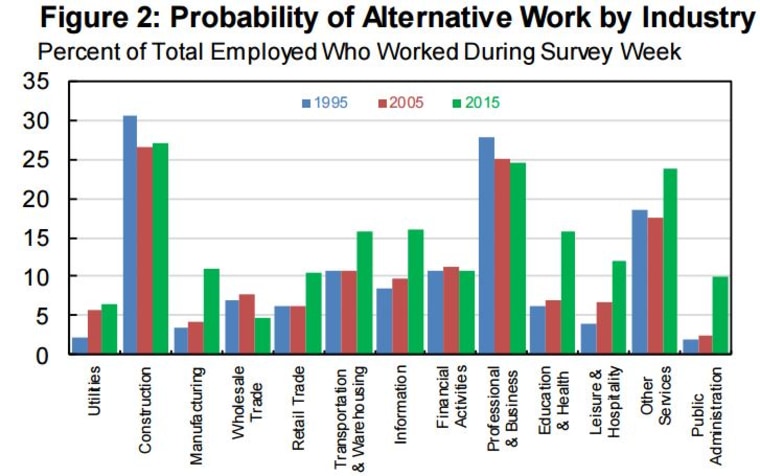If you're wondering why it's so hard to find a steady 9-5 job, here's a really good reason.
The answer could be a dark lining to last week's silvery jobs report. Unemployment fell to 4.6 percent for November, the lowest since the financial crash of 2008. It's also within the range of what Fed policy makers call "full employment."
But a recently updated study by Harvard and Princeton economists shows that 94 percent of "net job growth" -- the number of jobs created minus the number of jobs lost -- from 2005-2015 was in "alternative work."
It's a big bucket that includes independent contractors, freelancers, temp agencies, on-call employees, and people who work for contract companies, like janitors.
Yes, the Uber-driving, on-demand cupcake delivery economy is part of it — but a small one, just 0.5 percent of 2015 employment.
"The bottom line is that the nature of work is changing," study co-author Alan B. Krueger, a Princeton professor of economics told NBC News. "The traditional 9-5 steady job still exists, but it's less common than it used to be."

One aspect is that as companies have added back jobs that were cut, they want to have more flexibility. They staff up for specific projects and initiatives without bringing on board full-time workers — or having to pay for their health insurance.
They also have pushed on-demand scheduling for part-time employees who have to call in an hour or two ahead of time to find if they get to work that day.
Related: Employees Suing Bosses Over Lousy 401(k) Plans
Ultimately, the new hiring architecture makes payroll more efficient for companies, but pushes burdens onto employees. They must deal with erratic income, childcare, and other scheduling issues. The practice has resulted in labor lawsuits alleging wage theft.
Obamacare and monitoring technology has made this kind of contingent workforce more possible and in some ways appealing as a lifestyle choice.
"The Katz and Krueger evidence is mixed on whether these workers would prefer full-time regular employment," said Harvard economics professor Gabriel Chodorow-Reich. "Some would, others are happy with their alternative arrangement."
However, for some of the nation's workforce, the choice is either an "elastic" job — or none at all. And while employment may be close to full, it's not necessarily as filling.
"People need to be prepared to manage their own careers, particularly if they're working as a freelancer or independent contractor," said Krueger.
"They need to provide their own safety net and save for their own health insurance, save for retirement, save for periods of slack work. They cannot rely on the traditional safety net through W-2 employment."

